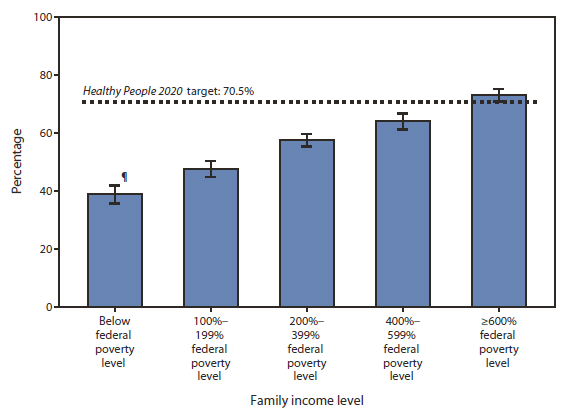Persons using assistive technology might not be able to fully access information in this file. For assistance, please send e-mail to: mmwrq@cdc.gov. Type 508 Accommodation and the title of the report in the subject line of e-mail.
QuickStats: Percentage of Adults Aged 50–75 Years Who Received Colorectal Cancer Screening,* by Family Income Level† — National Health Interview Survey, United States, 2010§

* Based on survey questions that asked respondents when they last had a blood stool test, sigmoidoscopy, or colonoscopy. "Unknowns" were not included in the denominators when calculating percentages. The U.S. Preventative Services Task Force recommends screening for colorectal cancer using fecal occult blood testing annually, sigmoidoscopy every 5 years with fecal occult blood testing every 3 years, or colonoscopy every 10 years for persons aged 50–75 years.
† Based on a U.S. Census Bureau definition of federal poverty level that includes information on family income, size, and composition.
§ Estimates were based on household interviews of a sample of the U.S. civilian, noninstitutionalized population. Denominators for each category excluded persons for whom data were missing. Estimates were age adjusted to year 2000 U.S. Census Bureau estimates using age groups: 50–64 years and 65–75 years.
¶ 95% confidence interval.
In 2010, the percentage of adults aged 50–75 years who received colorectal cancer screening as recommended by the most recent guidelines increased as income increased. Persons with family incomes 600% or more of the federal poverty level were nearly twice as likely (72.9%) to get a colorectal cancer screening than those with family incomes below the federal poverty level (38.7%) and were the only group to meet the Healthy People 2020 target of 70.5%.
Sources: National Health Interview Survey, 2010 Cancer Control Module. Available at http://www.cdc.gov/nchs/nhis.htm.
US Department of Health and Human Services, Office of Disease Prevention and Health Promotion. Healthy people 2020. Washington, DC: US Department of Health and Human Services; 2012. Available at http://www.healthypeople.gov.
Reported by: David T. Huang, PhD, dhuang@cdc.gov, 301-458-4213; Deepthi Kandi.
Alternate Text: The figure above shows the percentage of adults aged 50-75 years who received colorectal cancer screening, by family income level in the United States, during 2010. In 2010, the percentage of adults aged 50-75 years who received colorectal cancer screening as recommended by the most recent guidelines increased as income increased. Persons with family incomes 600% or more of the federal poverty level were nearly twice as likely (72.9%) to get a colorectal cancer screening than those with family incomes below the federal poverty level (38.7%) and were the only group to meet the Healthy People 2020 target of 70.5%.
Use of trade names and commercial sources is for identification only and does not imply endorsement by the U.S. Department of
Health and Human Services.
References to non-CDC sites on the Internet are
provided as a service to MMWR readers and do not constitute or imply
endorsement of these organizations or their programs by CDC or the U.S.
Department of Health and Human Services. CDC is not responsible for the content
of pages found at these sites. URL addresses listed in MMWR were current as of
the date of publication.
All MMWR HTML versions of articles are electronic conversions from typeset documents.
This conversion might result in character translation or format errors in the HTML version.
Users are referred to the electronic PDF version (http://www.cdc.gov/mmwr)
and/or the original MMWR paper copy for printable versions of official text, figures, and tables.
An original paper copy of this issue can be obtained from the Superintendent of Documents, U.S.
Government Printing Office (GPO), Washington, DC 20402-9371;
telephone: (202) 512-1800. Contact GPO for current prices.
**Questions or messages regarding errors in formatting should be addressed to
mmwrq@cdc.gov.
 ShareCompartir
ShareCompartir


